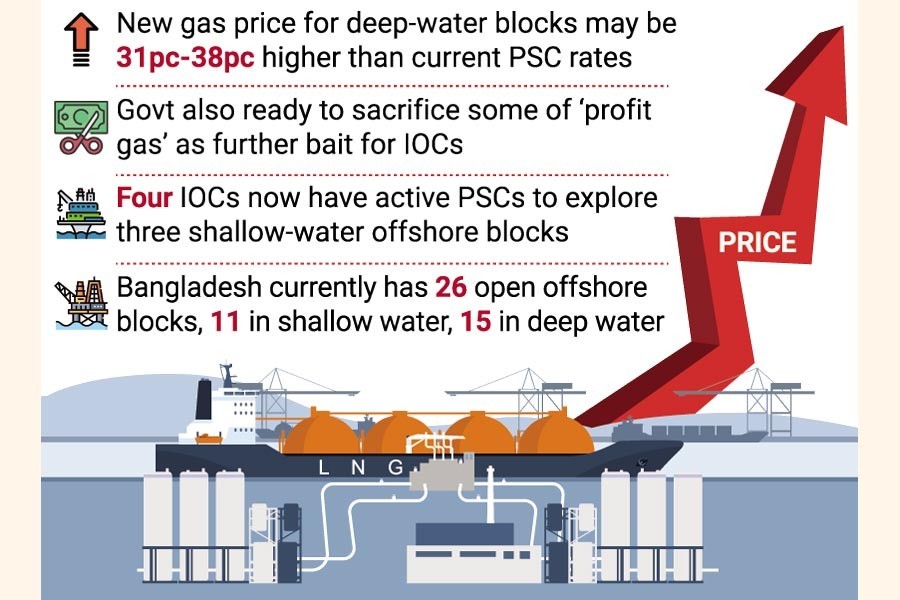The government plans to make the next round of offshore-exploration bidding attractive by linking its gas-purchase price with that of LNG in the international market.
The move is designed to rope in international oil companies (IOCs).
Brent crude price on the international market is set as the benchmark for fixing price of the natural gas.
"We are working to fix the new formula so that the price comes out between US$9.5 and US$10 per Mcf (1,000 cubic feet)," says a senior Petrobangla official.
If fixed in this market-based pricing formula, the new gas price for deep-water offshore blocks will be around 31-percent to 38-percent higher than the current price offered under the existing model production-sharing contract (PSC) 2019.
The government has taken the initiative for sweetening the model PSC in line with the recommendations from Scotland's Wood Mackenzie.
In the existing model PSC of 2019 natural gas prices for the IOCs are pegged to high-sulfur fuel-oil (HSFO) prices on the global market.
For shallow-and deep-water offshore blocks the ceiling price for HSFO is $215 per tonne, in accordance with the model PSC 2012.
The floor price in the model PSC 2019 and model PSC 2012was same at $100 per tonne.
With this formula, gas price for deep-sea blocks stands at $7.25 per Mcf with a hike by 11.53 per cent from the previous $6.50 per Mcf.
For shallow-sea blocks, the gas price stands at $5.50 per Mcf with a hike by 9.09 per cent from the previous $5.0 per Mcf under model PSC 2012.
Gas price for deep-sea blocks, however, was set to escalate by 1.5 per cent from the date of first gas output under the new model PSC 2019 instead of the 2.0-percent annual escalation in the previous model PSC 2012.
It would take around eight years for the IOCs to get the gas price at US$ 8 per Mcf and 16 years to get at US$9 per Mcf under the model PSC 2019.
Under the model PSC 2019 the price of natural gas to be produced from onshore, shallow-sea and deep-sea gas blocks was kept unchanged at 75 per cent, 100 per cent, and 130 per cent of marker price as defined in the Asian Petroleum Price Index.
In the planned model PSC for the next bidding round Petrobangla is also working to reduce government share in 'profit gas' between 40 per cent and 70 per cent from previous model PSC's 55 per cent to 80 per cent.
Profit gas means the available gas after the quantity corresponding to the value required for royalty payments and the investor has taken the cost gas under the PSC terms.
Petrobangla is also working for narrowing down differences of exploration benefits between deep-and shallow-sea blocks to attract the IOCs to take part in the next offshore bidding round.
"We have planned to launch a fresh bidding for hydrocarbon exploration by the IOCs in both deep-and shallow-water offshore blocks by December 2022," Petrobangla chairman Nazmul Ahsan told the FE Monday.
He said Petrobangla is working to update the model PSC to ensure participation of a good number of IOCs in the next bidding round.
Petrobangla previously had floated the last bidding round nine years back in 2012 through which three shallow-water blocks and one deep-water block were awarded to contractors.
Currently, four IOCs have active PSCs, either individually or under joint venture, to explore three shallow-water blocks for offshore exploration.
ONGC Videsh Ltd (OVL) and Oil India Ltd (OIL) are jointly exploring shallow-water blocks SS-04 and SS-09.
US oil-major Chevron is active in exploring and producing natural gas in three onshore gas-fields under onshore blocks 12, 13 and 14.
Singapore's KrisEnergy is producing natural gas from Bangora field under block 9.
Bangladesh currently has a total of 26 open blocks in offshore areas, of them 11 located in shallow water and the remaining 15 are in deep water.
"The upcoming bidding round is very important for ensuring the country's future energy security," Mr Ahsan said, as local gas shortages make the government opt for import of costly LNG or liquefied natural gas from the volatile global market.
Currently, Bangladesh imports lean LNG from RasGas of Qatar and Oman Trading International (OTI) of Oman to meet mounting natural-gas requirement.
Two operational 3.75 Mtpa (million tonne per annum)-capacity FSRUs - Excelerate Energy's Excellence and Summit LNG - are currently re-gasifying around 500 million cubic feet per day (mmcfd) of LNG in total to feed the consumers.
The country's overall gas output is around 2800 mmcfd including the re-gasified LNG of around 480 mmcfd.


